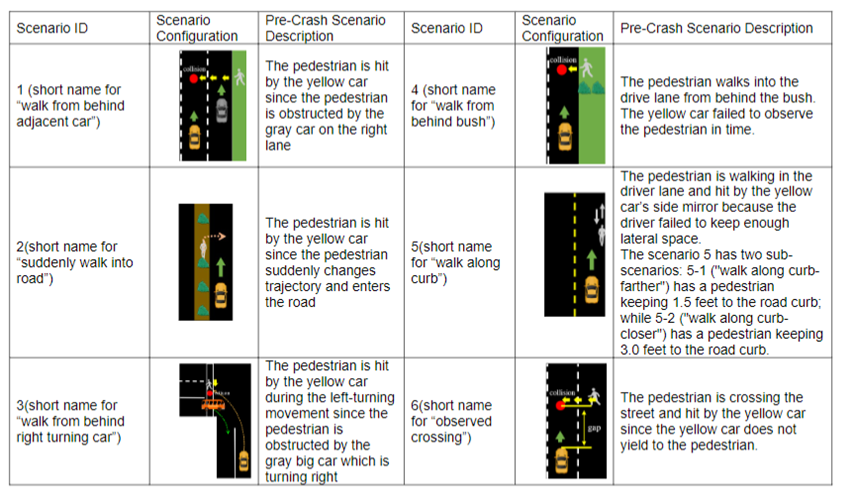A Driver Simulator Study on a Smartphone Based Pedestrian-to-Vehicle Warning Technology Demonstrated That Providing Additional Distance Information Leads to Improved Safety and Driving Performance.
Thirty-Six (36) Participants Tested Smartphone Based Pedestrian-to-Vehicle Application for Six Pedestrian Pre-Crash Scenarios in Driving Simulator Experiment.
Florida, United States
Investigating the Effects of Smartphone-Based P2V Warning Using Driving Simulator Experiments
Summary Information
Pedestrian to Vehicle (P2V) systems are used to allow a pedestrian to share his/her location information to nearby drivers to prevent drivers failing to observe pedestrians crossing an intersection. Utilizing the smartphone as a communication platform could make the P2V more applicable for old cars without having additional retrofits. This study examined the influence of P2V designs in different scenario conditions using driver simulator tests with 36 participants, and uncovered insights about potential variations between drivers. Six pedestrian pre-crash scenarios were considered, as shown in Figure 1. Two aspects of P2V design were tested, namely the warning display mode and warning content. The warning display mode was categorized into a gradually changed warning (the test P2V Design) and an emergency warning (the base P2V design). The warning content displayed specific distance information to the participants in the simulator. As for the driver features, three variables were: 1) not-at-fault crash experience 2) citation experience, and 3) Advanced Driver-Assistance System (ADAS) experience. Driver performance variables were recorded from each process of a driver’s decision making. These were throttle to release time (TRT), brake reaction time (BRT), brake-to-maximum brake time (BTMB), mean deceleration, maximum deceleration, jerk, stop indicator, and minimum distance and stopping distance.

Figure 1: Six Pedestrian Crash Scenarios Configured in the Simulator
- Provide additional distance information to improve driving comfort. This study tested whether adding the distance indicator and the color of the warning icon, which would be changed according to related distance metrics (scenario 5), would benefit drivers. The jerk (the deviation of acceleration) during the period in scenario 5-2 ("walk along curb-closer") was lower under the test P2V when additional distance information was provided. This indicated that the driving comfort was improved by allowing drivers to have more time to adapt to the possible danger.
- Study certain driver reactions such as BRT and TRT. The BRT and TRT were significantly larger in scenarios 1 and 4 for the test P2V design than those for the base P2V design. The reason was that drivers did not have to suddenly brake when the warning from the test P2V design since they had sufficient time to figure out where was the danger coming from. Also, the minimum distance and stopping distance increased in the test P2V design for certain scenarios.
- Calculate key performance measures such as the mean deceleration, maximum deceleration, stop indicator, and maximum brake. This study found that for scenarios 1, 3 and 4, these performance measures were lower in the test P2V design than the base P2V design. This phenomenon indicated that the driver did not need to use a hard brake to avoid a collision. In addition, the stop indicator performance in scenarios 1 and 4 was also lower for the test P2V design.
- Check for interaction effects between the test P2V design and driver features such as not-at-fault crash experience, citation experience, and ADAS experience. In scenario 1, the test P2V design (gradually changed warning) increased the BTMB for drivers who had involved in a not-at-fault crash before compared with the base P2V design (emergency warning design). As a larger BTMB means that the driver has a relatively gentle brake, the results indicated that the gradually changed warning may improve the brake performance of drivers who had been involved in a not-at-fault crash before since these drivers do not have to take a hard brake.
